

Regulating the prison phone industry
- Sections
- Our big-picture report
- Explainers about phone justice
- Contracts database
- Our advocacy
- Press coverage
The cost of everyday communication is arguably the worst price-gouging that people behind bars and their loved ones face. Why? Because prisons and jails profit by granting monopoly telephone contracts to the company that will charge families the most.
For twenty years, families had been calling on the Federal Communications Commission (FCC) to provide relief from the exorbitant bills that the prison phone companies charge just to stay in touch. Recognizing yet another way that mass incarceration punishes entire communities, the Prison Policy Initiative joined with partners across the country to help generate the research and advocacy that was necessary for change.
We’ve won some real victories at the FCC lowering rates and halting industry consolidation, we’re pushing for states to take action, and we’re keeping this industry and the perverse incentives it offers the sheriffs in the news. This page provides an overview of our research and advocacy:
Our big-picture report
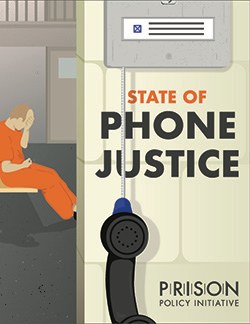 State of Phone Justice 2022:
State of Phone Justice 2022:
The problem, the progress, and what's next
How much should it cost to stay in touch with Mom or Dad when they're locked up? We gathered data showing that while some jails and their phone companies provide calls for as low as 1 or 2 cents a minute, the vast majority charge 10 times that amount or more. Data from 50 state prison systems and over 3,000 local jails and other facilities show that families are paying exorbitant rates, while companies find new ways to price-gouge them through an expanding array of non-phone products.
FCC briefings and older reports
2024:
2022:
- Comments on FCC proposed phone rules, September 12, 2022
- Reminding the FCC of the need to protect consumer prepaid funds, May 6, 2022
- Opening comments on FCC's proposed revisions to annual reporting requirements, January 12, 2022
- Opening comments on Securus Technologies' petition to allow subscription plans, January 7, 2022
2021:
- Reply comments on the FCC's rulemaking, including our proposal for regulating video calling, December 17, 2021
- Opening comments on the FCC's third mandatory data collection, November 4, 2021
- Opening comments on the FCC's next phase of rulemaking, September 27, 2021
- Informal complaints filed against five companies that double dip on ancillary fees, March 23, 2021
- Contracts that bundle voice telephone service with other communication technologies, March 23, 2021
- High third-party financial transaction fees reported by Global Tel*Link, February 25, 2021
2019:
- Comments in support of exempting all Inmate Calling Service carriers from Universal Service Fund contribution obligations, August 30, 2019

State of Phone Justice:
Local jails, state prisons and private phone providers
by Peter Wagner and Alexi Jones
Appendices
February 2019
Press release
2016:
- Ownership interests and single call loophole, March 10, 2016
- Video visitation, February 8, 2016
- FCC has jurisdiction over electronic messaging/email, February 8, 2016
- Closing the “Single Call” loophole, January 19, 2016
- Closing the Western Union and MoneyGram loophole, January 19, 2016
- Closing the “bundling unrelated services” loophole, January 19, 2016
- Video visitation update, January 19, 2016
2015:
- The industry’s campaign contributions exemplify why the FCC should focus on lowering the total cost of calls and not the varied forms of payments that commissions take, (Excerpts), August 12, 2015
- Address video visitation immediately after comprehensive regulation of the phones industry, July 6, 2015
- The state of the movement for prison phone justice (about editorial support for reform), June 12, 2015
- Reply to comments of local government officials, addressing why they don't need kickbacks on phone contracts, January 27, 2015
- Despite Idaho DOC’s claims, regulation is not increasing per-minute rates, January 26, 2015
- Fees continue to increase the cost of calls, January 12, 2015
- The need to regulate in-state rates, January 12, 2015
- Prison and jail phone companies seizing customer money (aka how the companies violate state laws re: unclaimed funds), January 12, 2015
- Single-call programs undermine regulation, January 12, 2015
- FCC should reject Securus, Global Tel*Link, and Telmate’s joint proposal, January 12, 2015
- The need for advanced communication services in prisons and jails, January 12, 2015
2014:
 Aleks Kajstura’s presentation at the FCC’s July 9, 2014 Workshop on Further Reform of Inmate Calling Services
Aleks Kajstura’s presentation at the FCC’s July 9, 2014 Workshop on Further Reform of Inmate Calling Services- Correctional facility type and phone regulation, January 13, 2014
- Third party fees in the prison phone market (about money transfer services like WesternUnion and MoneyGram), January 13, 2014
2013:

Please Deposit All of Your Money:
Kickbacks, Rates, and Hidden Fees in the Jail Phone Industry
by Drew Kukorowski, Peter Wagner and Leah Sakala
May 8, 2013Report (web version) or print/PDF version
Executive Summary
Exhibits
Appendix: Questions Sheriffs should ask the phone companies
Press release- Video visitation and email services, December 23, 2013
- The multiple incarnations of kickbacks that prison phone companies give to prisons and jails, August 1, 2013
- The difference between prisons and jails, July 17, 2013
- Since ‘Please Deposit All of Your Money’ some small companies have lowered their fees and improved policies, while other companies have been discovered to have charges and policies even worse than previously understood, July 17, 2013
 Peter Wagner’s presentation at the FCC’s July 11, 2013 Workshop on Reforming Inmate Calling Services
Peter Wagner’s presentation at the FCC’s July 11, 2013 Workshop on Reforming Inmate Calling Services
2012:
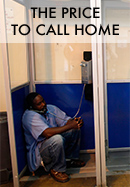
The Price To Call Home: State-Sanctioned Monopolization In The Prison Phone Industry
by Drew Kukorowski, September 11, 2012Report (web version) or print/pdf version
Press release
Correctional phone industry contracts
We've made our collection of correctional phone industry contract documents public. Search them to see what companies are profting in your area.
Explainers about phone justice
- FCC votes to slash prison and jail calling rates and ban corporate kickbacks
New rules, the result of the bipartisan passage of the Martha Wright-Reed Fair and Just Communications Act, are a massive victory in the decades-long fight for prison and jail communication justice.
by Wanda Bertram, July 18, 2024 - Calling on the FCC to make the most of its upcoming rulemaking on prison and jail telecom rates
Ahead of the FCC’s vote on new prison and jail phone rate caps, The Leadership Conference sent a letter to the agency, and we signed on.
by Wanda Bertram, June 20, 2024 - Recent data offer a detailed snapshot of the cost of family contact in local jails
Some of the questions we receive most often about communication policies (and rates) in local jails can finally be answered, thanks to two new resources from Michigan and Minnesota.
by Wanda Bertram, April 11, 2024 - Incarcerated people must be at the forefront of Biden Administration and Federal Trade Commission efforts to end “junk fees”
We joined the National Consumer Law Center and 27 other organizations to call on the Federal Trade Commission to crack down on abusive fees incarcerated people and their families are forced to pay.
by Mike Wessler, February 8, 2023 - Since You Asked: What’s next for prison and jail phone justice now that the Martha Wright-Reed Just and Reasonable Communications Act is law?
We explain what the new law accomplishes, how the FCC can — and should — enforce it, and why the fight for phone justice is not over.
by Wanda Bertram, January 19, 2023 - A million here, a million there, and pretty soon you’re talking real money: Class-action settlement reveals Global Tel*Link’s addiction to seizing customer money
Evidence from court case shows why the FCC should act to stop abusive practices in the industry.
by Stephen Raher, September 7, 2022 - Prison Policy Initiative asks FCC to reject prison phone company’s request for special treatment to peddle “subscription” phone plans
Securus wants the FCC to waive its rules, but won’t disclose important details about how the plans work.
by Wanda Bertram, January 10, 2022 - Research roundup: The positive impacts of family contact for incarcerated people and their families
The research is clear: visitation, mail, phone, and other forms of contact between incarcerated people and their families have positive impacts for everyone — including better health, reduced recidivism, and improvement in school. Here’s a roundup of over 50 years of empirical study, and a reminder that prisons and jails often pay little more than lip service to the benefits of family contact.
by Leah Wang, December 21, 2021 - Calling on the FCC to address the high cost of jail phone calls
This week, the Prison Policy Initiative filed comments urging the FCC to take steps to lower jail phone costs and stop unfair practices by the correctional phone industry.
by Stephen Raher, September 29, 2021 - New data: Wisconsin jails and telecom giants profiting from high phone rates that keep families apart
As people in jail and their families struggle to stay connected during the pandemic, we've collected the data on the exploitative prices families are forced to pay in....
by Wanda Bertram, September 10, 2021 - What families can expect to be charged under the new FCC rules
A new order from the Federal Communications Commission lowers existing caps on rates and fees in the prison and jail telephone industry.
by Andrea Fenster, June 10, 2021 - It’s all about the incentives: Why a call home from a jail in New York State can cost 7 times more than the same call from the state’s prisons
Families with loved ones incarcerated in New York State prisons pay some of the lowest phone fees in the entire country. Meanwhile, those with loved ones in the state's....
by Katie Rose Quandt, March 23, 2021 - We’ve saved Iowa consumers $1 million per year on jail phone calls — but there’s more work to do to stop exploitation in Iowa & beyond
We’re fighting for fair phone rates for people in jail and their families, and we just picked up a big victory. We pressured officials in Iowa to regulate the....
by Wanda Bertram, March 10, 2021 - People in jails are using more phone minutes during the COVID-19 pandemic, despite decreased jail populations
Our study of 14 jails finds that there were 8% more overall minutes used during the pandemic, despite the fact that nationwide jail populations have fallen about 15%.
by Andrea Fenster, January 25, 2021 - Since you asked: Can correctional facilities negotiate phone contracts that prohibit deposit fees? (Yes! Many do.)
We review the evidence and find 15 states that said no to unnecessary fees. Who will be next?
by Peter Wagner, November 20, 2020 - Prison Policy Initiative asked California Public Utilities Commission to cap the cost of calling home from California jails
Yesterday, the Prison Policy Initiative filed comments before the California Public Utility Commission, calling for it to reduce the cost of calling home from California....
by Peter Wagner, November 10, 2020 - Prisons and jails are rolling back free phone and video calls. They should be extending them instead
Amidst a pandemic and recession, policymakers should be fighting for extended — if not permanent — financial relief for incarcerated people and their families.
by Wanda Bertram, September 11, 2020 - Hey Massachusetts state legislature, please pass S.2846!
S.2846 will make phone calls free of cost for incarcerated people and their families in Massachusetts.
by Jenny Landon, September 4, 2020 - Jails and prisons are suspending visits to slow COVID-19. Here’s what advocates can do to help people inside.
Send our letter to your local jail, asking them to make video and phone calls free.
by Bernadette Rabuy, March 17, 2020 - The biggest priorities for prison and jail phone justice in 40 states
High prison rates, high jail rates, high first minute charges, and more
by Peter Wagner, September 11, 2019 - When jails replace in-person visits with video, what happens when the technology fails?
As more jails ban face-to-face visits in favor of paid video chats, a growing number of people in jail are being cut off from their families when the technology breaks down.
by Sarah Watson, June 18, 2019 - Victory for phone justice: Securus and ICSolutions abandon attempted merger
A merger between the two companies would have curtailed the ability of prisons and jails to choose a phone provider, to the detriment of incarcerated people and their families.
by Wanda Bertram, April 2, 2019 - California policymakers renew the struggle for in-person visits
California's AB 964 would require in-person visits in all California jails
by Bernadette Rabuy, March 30, 2019 - On kickbacks and commissions in the prison and jail phone market
Phone providers are so creative in their influence-peddling that the most viable reform strategies do not focus only on "commissions."
by Peter Wagner, February 11, 2019 - Why expensive phone calls can be life-altering for people in jail – and can derail the justice process
The cost of jail phone calls punishes people in the most desperate circumstances, most of whom have not been convicted of a crime.
by Wendy Sawyer, February 5, 2019 - Timeline: The 18-year battle for prison phone justice
The fight to make prison and jail phone calls affordable began in 2000. For those wondering "why is this taking so long?", here are the key dates.
by Peter Wagner, December 17, 2018 - Securus asks FCC to look the other way while it expands; advocates and families call its bluff
In our rebuttal to Securus, we disprove the company's claims of healthy competition in the prison phone market.
by Aleks Kajstura, July 31, 2018 - New York City to make all calls from jail free
New York City becomes the first jurisdiction to make calls home from jails free. Who else is going to follow this smart step?
by Peter Wagner, July 19, 2018 - Comment letter: Florida’s Department of Corrections should not reduce visitation
In our letter to the Florida Department of Corrections, we explain why cutting visiting hours is bad policy and an inhumane practice.
by Lucius Couloute, May 31, 2018 - Your location data: free to anyone with a Securus contract
For nearly a year, the FCC knew about Securus’s cellphone tracking and turned a blind eye.
by Aleks Kajstura, May 11, 2018 - Senate bill targets recalcitrant FCC; revitalizes federal fight to lower the cost of calling home
Senators introduced S 2520 in bipartisan effort to put FCC back on track in regulating the cost of calling home from prison or jail.
by Aleks Kajstura, March 12, 2018 - Growing momentum in the fight to preserve in-person visits
New policy changes and legislative efforts designed to address correctional visitation policies are helping to chip away at the inhuman treatment of incarcerated people across the United States.
by Lucius Couloute, March 5, 2018 - Findings from Knox County, Tenn.: Replacing in-person visits with video calling is bad policy
A new report highlights how the replacement of in-person visits with video calling makes jails less safe, but more profitable for sheriffs.
by Lucius Couloute, January 30, 2018 - The Guardian and Colorado Public Radio raise urgent questions about the video calling industry
Virtual jail "visits" are quietly sweeping the country. Fortunately, a surge of hard-hitting journalism is pushing back, illuminating the exploitative practice of eliminating family visits in favor of video calls.
by Lucius Couloute, December 14, 2017 - A few thoughts on legislative compromises
We've had to make tough compromises in our work to protect in-person jail visits. We share some of the considerations we confronted in the hopes of supporting other advocates.
by Bernadette Rabuy, November 20, 2017 - Jail phone companies flood money into sheriff races
New research shows jail phone companies contributing significant sums to Sheriff's campaigns, in one case funding a quarter of Sheriff's campaign spending.
by Aleks Kajstura, October 12, 2017 - Video Conferencing Enthusiasts Slam Replacement of In-Person Jail Visits with Video Calls
Video conferencing enthusiasts agree: video calls are not the same as in-person visits
by Bernadette Rabuy, September 26, 2017 - Comment letter: Maine’s Department of Corrections should not allow correctional facilities to eliminate in-person visitation.
After the Maine DOC solicited comments on the proposed changes to its visitation policies, we submitted a letter detailing why the elimination of in-person visits would hurt families.
by Lucius Couloute, September 7, 2017 - California legislators continue fighting for in-person jail visits
California legislators hold hearing on video calls and sharply criticize the dangers of banning in-person visits
by Bernadette Rabuy, September 6, 2017 - Prison phone giant GTL gets bigger, again.
GTL has purchased competitor Telmate, meaning higher prices for families and facilities. We examine GTL and Securus domination of the industry.
by Peter Wagner, August 28, 2017 - Voices that matter: Incarcerated people on video calling
If policymakers are legitimately concerned about making the transition out of correctional facilities as smooth as possible, they must incorporate the visitation-related concerns of incarcerated people. This post examines a few of those important concerns.
by Lucius Couloute, August 9, 2017 - Securus’ claims of low rates undermined by Securus’ actual rates
Securus claims average rates of under 20 cents a minute, Wright Petitioners find no rates under 50 cents in all of Michigan.
by Aleks Kajstura, July 31, 2017 - Senator Tammy Duckworth introduces the Video Visitation and Inmate Calling in Prisons Act of 2017
Senator Tammy Duckworth recently introduced the Video Visitation and Inmate Calling in Prisons Act of 2017. This piece of legislation is an important step in the fight against exploitation in prisons and jails, and we encourage lawmakers, criminal justice professionals, and the general public to support its passing.
by Lucius Couloute, July 24, 2017 - Vice News Tonight examines the exploitative video visitation industry
Vice News Tonight examines the growth of the exploitive video visitation industry; highlighting the human toll of switching from the real thing to an artificial – and costly – substitute.
by Lucius Couloute, June 28, 2017 - Advocates ask FCC to block sale of Securus, investigate prison phone giant’s disregard for regulations
Securus fights against regulations and then flouts the ones that survive. FCC should investigate, not approve sale.
by Aleks Kajstura, June 21, 2017 - For families of incarcerated dads, Father’s day comes at a premium
Over 1.5 million children have a father incarcerated in prison today. As Father's day approaches, millions of children will be without their fathers, and without the ability to pay the outrageous fees associated with speaking to them. State lawmakers should take the initiative to better regulate prison telecom companies, and most importantly, reduce the number of incarcerated people.
by Lucius Couloute, June 13, 2017 - Detroit Pistons owner about to squeeze fans in a new way, buying Securus
If Tom Gores and Platinum Equity are trying to improve lives, Securus is the wrong investment. As the second-largest prison and jail telecom company in the country, is arguably one of the most exploitative companies profiting from mass incarceration.
by Wendy Sawyer, May 18, 2017 - In their own words: The value of in-person visitation to families
As sheriffs consider eliminating in-person visitation in jails, the firsthand experiences of incarcerated people and their families remind us that in-person visitation is crucial to the reentry process and reducing recidivism.
by Emily Widra, May 9, 2017 - American Correctional Association says that video visitation should not replace in-person visits
We are thrilled to see the ACA support the common sense idea that emerging technologies should supplement, not replace, in person visits.
by Lucius Couloute, April 24, 2017 - Phone Tag to Computer Hack: Securus puts privacy at risk
Are providers of prison communication services allowing unrestricted access to the personal computers and conversations of incarcerated people and their loved ones?
by Stephen Raher, April 24, 2017 - Protecting incarcerated people and their loved ones from the video visitation industry
Some legislators are beginning to take notice of the abusive video visitation industry. Policymakers across the country should consider adopting legislation so that incarcerated people and their families are not prevented from face-to-face contact during difficult times.
by Lucius Couloute, April 10, 2017 - Court hears industry lawsuit against FCC regulation of prison and jail telephone industry
We explain what's next and what the families can expect on telephone justice.
by Peter Wagner, February 8, 2017 - Support for in-person visitation continues to grow
From state and federal legislation to the press, support for in-person visits continues to grow.
by Bernadette Rabuy, February 1, 2017 - Evading regulation, some in-state phone calls from jails cost over $1.50 a minute
The first ever national survey of in-state jail phone rates finds some jails charge more than $1.50 a minute.
by Aleks Kajstura, January 19, 2017 - Congress and NPR tackle phone justice and video visitation this week
NPR covers video visitation, and reform legislation is introduced in Congress.
by Peter Wagner, December 8, 2016 - In-person visits return to jails in Travis County, Texas!
For the first time since 2013, in-person visits will be allowed at Travis County jails.
by Alison Walsh, April 19, 2016 - Travis County, Texas: A Case Study on Video Visitation
Travis County, Texas' experience shows: video visitation often fails to meet expectations.
by Emily Widra, April 18, 2016 - What families can expect to be charged for phone calls
The federal courts have issued a second stay of the FCC's October 2015 order. Families should expect caps and bans on ancillary fees.
by Bernadette Rabuy, March 24, 2016 - Despite court stay, Mississippi sets new phone rates in accordance with FCC order
Mississippi just slashed its phone rates beyond what was required. What does that say to the states challenging the FCC's original order?
by Alison Walsh, March 23, 2016 - What families can expect from the new FCC rules
We explain what rates and fees to expect thanks to the FCC's October 2015 order and when for prisons and jails.
by Peter Wagner, March 17, 2016 - Indiana, Oklahoma, and Arkansas undermine their own criminal justice reform agenda with challenge of FCC regulation of prison phone industry
Just what are governors who talk about the need for prison reform doing trying to stop the FCC's historic effort to protect the families of incarcerated people from exploitative prison phone companies?
by Emily Widra, March 14, 2016 - FCC, your work isn’t over. Protect families from advanced communication services.
Our latest comments urging the FCC to regulate advanced communication services in correctional facilities.
by Alison Walsh, February 12, 2016 - FCC’s next regulations should cinch loopholes and address video visitation
In response to the FCC's request for comments, we submitted four analyses of unresolved issues
by Aleks Kajstura, January 21, 2016 - Iowa Governor pledges to address cost of prison and jail phone calls
The Iowa Governor's Working Group On Justice Policy takes up our recommendations on phone justice.
by Peter Wagner, December 28, 2015 - FCC publishes order, seeks further comments
On Friday, the FCC's latest order was published in the Federal Register.
by Aleks Kajstura, December 21, 2015 - Prison profiteers use campaign contributions to buy contracts
How do the campaign contributions of the prison phone industry compare to those of the private prison industry?
by Peter Wagner, November 25, 2015 - FCC passes order to regulate prison and jail telephone industry
The Federal Communications Commission today approved a new order regulating the prison and jail telephone industry and reducing the cost of calling home from prisons and jails
by Peter Wagner, October 22, 2015 - What can states do after the FCC has ruled?
We have two ideas for state legislative strategies to further reduce the cost of calling home from prisons and jails.
by Peter Wagner, October 21, 2015 - Casting call: Protect the FCC’s regulation of the prison and jail telephone industry
Are you are a writer, actor or video person who cares about justice? We need to talk.
by Peter Wagner, October 16, 2015 - FCC commissioners reveal details of their proposal to protect all families of incarcerated people
Their proposal would give families the telephone justice they have been asking for.
by Peter Wagner, October 1, 2015 - In-person family visits will return to Austin, Texas
Travis County, Texas will bring back in-person visits that were replaced with video visits in 2013
by Bernadette Rabuy, September 30, 2015 - What would prison telephone justice look like?
What would effective state executive or legislative action for prison and jail telephone justice look like?
by Peter Wagner, September 29, 2015 - Help us stay one step ahead of the exploitative prison phone industry
Prison phone companies are sneaky but we've learned how to uncover their tricks. Will you help us stay one step ahead?
by Peter Wagner, September 11, 2015 - Are campaign contributions the new “commission”? Analysis of Securus’s contributions in Sacramento
Why is Securus one of the largest campaign contributors to the Sacramento County Sheriff?
by Peter Wagner, August 12, 2015 - Alabama’s new phone rates go into effect
Starting tomorrow Alabama begins implementing their prison and jail phone regulations which cap rates and fees for in-state calls. The Alabama Public Service Commission....
by Aleks Kajstura, June 30, 2015 - Uncovering Securus’ profits
Securus exemplifies the industry's obscene penchant for squeezing profits by fleecing their customers and shorting their business partners.
by Peter Wagner, June 19, 2015 - The prison phone industry’s new business model: Fee Harvesting
Some of these companies call themselves phone companies, but the phone service is little more than a gimmick to charge expensive fees.
by Peter Wagner, June 18, 2015 - Arkansas DOC to implement Securus video visits
Arkansas DOC will be first state prison system with Securus video visits
by Bernadette Rabuy, April 15, 2015 - The demographics of computer ownership and high-speed internet access
The poor, the elderly, and African-Americans and Latinos are less likely to have computers or high-speed internet at home. Replacing regular jail visits with computer video chats is a bad idea.
by Peter Wagner, March 17, 2015 - New videos: Video visitation is not “just like Skype”
4 short comedy videos reject that video visits are "just like Skype"
by Bernadette Rabuy, February 18, 2015 - Exploiting Inmates
"Exploiting Inmates" by Sukey Lewis in today's East Bay Express presents a great comprehensive overview of the current problems with the prison and jail phone industry
by Aleks Kajstura, February 4, 2015 - No surprise: Securus refund disaster
I waste 25 minutes for a visit that never happens, and Securus gets to keep my money anyway.
by Bernadette Rabuy, February 3, 2015 - Multnomah County Sheriff reverses ban on in-person visits in Portland jails!
Portland jails will now let families visit via video or in-person
by Bernadette Rabuy, January 29, 2015 - Department of Justice study: Video visitation is not an invitation to ban in-person visitation
DOJ study on video visitation: In-person visits are a best practice that should be protected
by Bernadette Rabuy, January 28, 2015 - Prison and Jail Video Visitation: A forward-looking idea implemented badly
New Prison Policy Initiative report finds video visitation actually punishes families
by Bernadette Rabuy, January 14, 2015 - Six briefings on prison telephone justice
On Monday evening, we submitted 6 major briefings on the need to regulate the prison and jail telephone industry to the Federal Communications Commission.
by Peter Wagner, January 14, 2015 - Eric Lotke talks about his new novel and the need for prison phone justice
In this new video, our Board President, Eric Lotke talks about his new novel, Making Manna and the connection to the struggle for prison phone justice and the Prison....
by Peter Wagner, December 29, 2014 - Support prison phone justice on this Giving Tuesday!
Generous friends have agreed to match any donations to PPI through 2014, making your gift go twice as far.
by Leah Sakala, December 2, 2014 - New video explains jail telephone industry’s hidden fees
One company produces a video explaining to Sheriffs how the status quo is bad for them.
by Peter Wagner, November 25, 2014 - New opportunity to weigh in on FCC prison phone regulation
Join us in telling the FCC to ensure that ALL families can afford to stay in touch with incarcerated loved ones
by Leah Sakala, November 21, 2014 - Dallas County approves video visitation contract
Today, in a partial reversal, the Dallas County Commissioners Court approved a new contract with jail telephone giant Securus.
by Peter Wagner, November 11, 2014 - Sheriff Joe Arpaio phases out in-person visits in Maricopa
Infamous Sheriff Joe Arpaio replaces in-person visits with video visitation
by Bernadette Rabuy, November 10, 2014 - New FCC prison phone regulation proposal play-by-play
Will the FCC ban commissions, cap all calling rates, and eliminate fees?
by Leah Sakala, October 27, 2014 - FCC considers next steps to protect families from predatory prison and jail telephone industry.
We need your help now to counter the powerful prison phone lobby.
by Peter Wagner, October 17, 2014 - Prison bankers cash in on captive customers
Center for Public Integrity releases first part of a series on web of prison bankers, private vendors, and corrections agencies profiting off families of the incarcerated.
by Bernadette Rabuy, September 30, 2014 - Next Steps on prison and jail phone reform: Joint statement by Chairman Wheeler and Commissioner Clyburn
"The wheels of justice turn slowly, but today we prepare to take the next critical step toward reducing the high price paid by inmates and their families to communicate"
by Aleks Kajstura, September 26, 2014 - FCC Commissioners are proposing to protect families from in-state prison phone gouging
Two commissioners circulate a proposal that would extend last year's historic ruling protecting some families from the predatory prison and jail telephone industry.
by Peter Wagner, September 25, 2014 - Tired of corporate stalling, petitioners submit prison phone companies’ own data to FCC
Martha Wright and her fellow petitioners mine prison phone companies' state-mandated disclosures to submit rate data to the FCC when the companies refuse answer the basic questions themselves.
by Aleks Kajstura, September 23, 2014 - Dallas County rejects Securus video visitation contract!
Dallas County tells Securus: No we won't end visiting hours at jail and require expensive video visitation instead.
by Peter Wagner, September 9, 2014 - Dallas Texas to consider banning free in-person visits, requiring expensive video visits instead
Later this morning, Dallas County Texas will vote on a new telephone contract with Securus that will also ban free in-person visits and require families to pay for video....
by Peter Wagner, September 9, 2014 - CenturyLink and Pay-Tel offer a peek down the rabbit hole of the prison phone industry
Where 96% isn't 96% and clients aren't clients.
by Leah Sakala, September 2, 2014 - PPI’s Aleks Kajstura presents at FCC workshop on further regulation of the prison phone industry
Aleks Kajstura gave an invited presentation of our research on two different workshop panels, highlighting the importance of fees and comprehensive reform.
by Leah Sakala, August 20, 2014 - John Oliver takes on the U.S. prison system
Awesome piece with one small mistake on the difference between prisons and jails.
by Peter Wagner, August 4, 2014 - FCC hears how high cost of calls can end parental rights
David Carliner Award Finalist Barbara Graves-Poller tells the FCC that New York prison phonecall price gouging routinely causes people to lose their parental rights.
by Peter Wagner, July 24, 2014 - Alabama to rein in third-party payment profit sharing in prison telephone industry
Alabama’s new rules will force prison phone industry to end kickbacks from Western Union/MoneyGram.
by Peter Wagner, July 21, 2014 - Huffington Post: The Father’s Day Profiteers That Put Hallmark to Shame
The Huffington Post just published my new article, The Father's Day Profiteers That Put Hallmark to Shame. Here's how it starts: This Sunday, more than a million families....
by Leah Sakala, June 13, 2014 - The Mothers Day Phone Rip-Off
This Mother's day, hundreds of thousands of kids won't be able to call their mothers, and if Mom calls them, those kids are going to have a hard time paying for the call if she calls them.
by Peter Wagner, May 9, 2014 - PPI weighs in on New York Times Room for Debate on video visitation
"[I]f left unregulated, the video communication market could follow the trajectory of the infamously broken prison telephone industry."
by Leah Sakala, February 28, 2014 - HuffPo: FCC Bests Prison Telephone Industry Just in Time for Valentine’s Day
Peter and Leah wrote a new Huffington Post piece about the start of the FCC's inter-state prison phone rate regulation on Tuesday.
by Leah Sakala, February 13, 2014 - Today the FCC dragged the prison telephone industry kicking and screaming into the 21st century
The two largest prison phone companies, mislead correctional facilities and federal regulators by acting like communications technology is stuck in the 1950s.
by Peter Wagner, February 11, 2014 - PPI sparks New York Times column “Phoning From Prison, at Prices Through the Roof”
We asked The New York Times consumer protection columnist the Haggler to investigate the broken prison phone industry. He did!
by Leah Sakala, February 3, 2014 - FCC should remain persistent on prison phone progress
We submitted additional comments to the FCC confirming more kickbacks, and urging the FCC to keep protections in place for people in jail.
by Aleks Kajstura, January 15, 2014 - Portion of FCC prison phone regulations put on hold; rate caps to go into effect 2/11
Court orders stay on some of the FCC's new prison phone regulations, but caps on call rates still go into effect on February 11th.
by Aleks Kajstura, January 14, 2014 - New York Times editorial cites PPI research on correctional video communication industry
"…the Prison Policy Initiative, a Massachusetts research group, urged similar rules for video visitation, email, voice mail and other systems."
by Leah Sakala, January 7, 2014 - FCC should close video loophole in prison phone regulation
Increasing the number of ways that families can stay in touch is a good thing. But allowing companies to exploit families and undercut the FCC's efforts to bring fairness to this industry is not.
by Leah Sakala, December 23, 2013 - Tell the FCC that all families need to stay in touch
We're partnering with SumOfUs to collect petitions supporting the FCC's next steps in regulating the prison phone industry.
by Aleks Kajstura, December 4, 2013 - FCC denies phone companies’ pleas to delay fair rates
The FCC denies prison phone companies’ petitions to delay implementing fair rates, reiterating the need for regulation.
by Aleks Kajstura, November 26, 2013 - Alabama should implement proposed prison phone reform
PPI submits letter to Alabama Public Service Commission supporting proposed regulations to reign in exorbitant costs jails and prison phone calls.
by Aleks Kajstura, November 14, 2013 - FCC prison phone regulation ruling published in Federal Register, to take effect Feb 11.
Companies and correctional facilities can no longer collude to profit off of keeping families apart.
by Peter Wagner, November 13, 2013 - Prison phone company to expand most costly service?
Prison phone company that recently raised their exorbitant fees even higher, recently took steps to bolster their still unregulated single call program.
by Aleks Kajstura, November 8, 2013 - Alabama seeks to curb high cost of prison and jail phone calls
Alabama Public Service Commission caps phone rates and limits fees charged for phone calls from correctional facilities.
by Aleks Kajstura, October 9, 2013 - A prison phone industry giant said what??
The Huffington Post just published the first article we’ve seen on the prison phone regulation that includes a public interview with the CEO of Securus.
by Leah Sakala, September 10, 2013 - Prison phone giant Securus cashes in, raises fees
While the FCC drags its feet on regulating the prison phone industry, the industry is wasting no time raking in the profits.
by Peter Wagner, September 5, 2013 - Prison Legal News covers historic FCC workshop on the prison phone industry
The article includes a nice summary of Peter's invited presentation on a panel about the true costs of providing prison phone service.
by Leah Sakala, August 29, 2013 - When is a customer not a customer? (In prison.)
A New York Times Magazine article exposes how the broken prison commissary industry leaves the people footing the bill out of the equation.
by Leah Sakala, August 20, 2013 - FCC takes historic stand to control the predatory prison and jail phone industry
the FCC is finally stepping up to the plate to protect families from having to choose between staying in touch and paying the bills.
by Leah Sakala, August 9, 2013 - The good old days of the exploitative prison phone industry?
2002 footage shows how much the industry has changed in 10 years.
by Leah Sakala, August 9, 2013 - Hiding commission payments and bypassing regulation
Letter to FCC: crafting effective regulation for prison phone market requires taking a comprehensive view of the commission system, ending high rates.
by Aleks Kajstura, August 3, 2013 - New York prison system tells FCC meaningful prison phone regulation is possible
New York has found that "there are significant benefits that can be attributed to lower calling rates."
by Leah Sakala, July 10, 2013 - PPI will expose hefty fees and commissions at FCC workshop on prison phone service
The workshop is from 9am-5pm EST Wednesday July 10th, and the FCC needs to hear from you. Find out how to participate.
by Leah Sakala, July 9, 2013 - New video: The high cost of calls home from the Hampden County Jail
Our new video shines some light on the dark underbelly of the telecommunications industry.
by Leah Sakala, July 9, 2013 - FCC has questions on prison phone service fees, we have answers
The FCC wants to know about the many fees prison phone companies charge. While the companies aren't talking, we've got answers.
by Leah Sakala, July 8, 2013 - PPI’s “Unlocking Prison Phone Data” Hackathon project on NCTV
Peter Wagner and Jake Mitchell talk about their software to make prison phone justice documents on the FCC website accessible to the larger movement.
by Leah Sakala, June 28, 2013 - The Phone Corporations That Ruined Fathers Day
On Sunday, some families had to choose between wishing dad a Happy Father’s Day on the telephone and putting food on the table.
by Peter Wagner, June 18, 2013 - Securus agrees that it’s ripping customers off via outrageous prison phone fees
But will they take their own advice and stop charging customers to get their own money back?
by Leah Sakala, June 11, 2013 - Unlocking the FCC data at Hack for Western Mass
A team of civic-minded hackers in Western Massachusetts have built a tool to make it easier to access documents about the FCC proceeding on regulating the prison telephone industry.
by Peter Wagner, June 3, 2013 - Thoughts on processing fees in the jail telephone industry
Some additional observations about prison phone fees, based on discussions we had with the phone companies after the report’s release.
by Peter Wagner, May 29, 2013 - Our report leads two phone companies to clarify & improve policies
As a result of the report, at least two companies, Turnkey and NCIC, made several clarifications and improvements to their fee policies.
by Peter Wagner, May 28, 2013 - Please Deposit All of Your Money: Kickbacks, Rates, and Hidden Fees in the Jail Phone Industry
The newest Prison Policy Initiative report exposes the prison phone industry's hidden fees, which saddle the families of incarcerated people with staggeringly high phone bills.
by Leah Sakala, May 8, 2013 - Movement victory: FCC proposes to regulate prison phone rates
At a Nov. 15th phone justice rally in Washington D.C., we, along with our partners at SumOfUs, delivered signatures from 36,690 people across the country calling on the FCC to rein in predatory prison phone rates. And it looks like the FCC will act soon -- Commissioner Mignon Clyburn announced that the FCC Chairman has circulated a prison phone regulatory proposal that the commission will now vote on.
by Leah Sakala, November 15, 2012 - New York Times editorial cites our prison phone industry report
The New York Times cited "The Price to Call Home: State-Sanctioned Monopolization in the Prison Phone Industry" in an editorial calling on the Federal Communications Commission to cap prison calling rates.
by Leah Sakala, September 24, 2012 - New PPI report “The Price To Call Home: State-Sanctioned Monopolization In The Prison Phone Industry”
A new Prison Policy Initiative report reveals that the monopolistic prison phone industry’s high calling rates are jeopardizing public safety and taxing poor communities. The report calls on the FCC to set price caps that would allow incarcerated people to increase their chances of success upon release by staying connected to their families.
by Leah Sakala, September 11, 2012
Our advocacy
Beyond our national work seeking stronger federal regulations, raising the issue of prison phone exploitation in the press, and sparking state-level advocacy, we've also been deeply involved in several states' regulatory proceedings.
Our work in California
We're calling for the California Public Utilities Commission to reduce the cost of calling home from California prisons and jails by imposing rate and fee caps. For more information, see:
- Our press release from November 10, 2020
- Our November 9, 2020 opening comments urging the California Public Utilities Commission to impose rate and fee caps for intrastate voice and video calling
- Our November 19, 2020 reply comments to the CPUC, about the need for action to lower the cost of calling home and the CPUC's ability to do so
- Joint comments (January 28, 2022 filed jointly by Prison Policy Initiative, The Utility Reform Network, the Center for Accessible Technology, and the California Public Advocates Office regarding the need for the PUC to regulate correctional video calling
- Joint reply comments (February 28, 2022) (from the same coalition noted above) rebutting the industry's arguments against regulating video-calling rates
- You can check on the current status of the California PUC proceeding by reviewing the official docket for proceeding R20-10-002
- In May 2022, prison telecom provider Securus Technologies filed a lawsuit in the California Court of Appeals, seeking to overturn the California PUC's 7-cent rate cap for voice calling. Prison Policy Initiative is defending the state's rate cap — we filed our response to Securus on June 29, 2022
- Our survey of phone rates in 2018 and 2020 and our survey of video calling bundling and rates in county jails in California
Our work in Iowa
We pushed the Iowa Utilities Board to regulate several jail phone providers — and won. Our campaign in Iowa is part of our national strategy to encourage state regulators to address unreasonable rates and fees charged by the jail phone industry. For more information, see:
- Explainer about our victory in Iowa as well as our ongoing advocacy. (March 10, 2021)
- Coverage in The Cedar Rapids Gazette of our advocacy and victory.
- Key filings:
- Our September 19, 2019 comment letter urging the Board to cap the cost of calling from from jails and to reign in consumer abuse.
- Our July 8, 2019 comment letter urging the IUB to collect commission data and suggesting how the IUB can reign in consumer abuse.
- Our May 13, 2019 comment letter with our detailed review of the tariffs and our proposals
- Press release published at the beginning of our campaign, April 26, 2019
- Key resources:
- Table showing the rates and providers for all Iowa county jails, early 2021
- The dockets for Reliance, Prodigy, Securus, Global Tel*Link and Encartele plus the Board's Notice of Inquiry NOI-2019-0001.
- Contracts and commission reports from select Iowa counties
- Early press coverage in The Des Moines Register, The Gazette (1 and 2), and the Mason City Globe Gazette.
Our work in Nevada
We are participating in Nevada's legislatively-mandated regulatory proceeding on the cost of in-state calling from prisons and jails. Our filings are available below:
- Our Opening comments (February 23, 2022) urging the Nevada Public Utilities Commission to lower rates and fees for in-state calls from prisons and jails
- Our Reply comments (March 9, 2022) responding to arguments from the correctional telecom industry
- Our Comments regarding the PUC's draft rule (April 19, 2022)
- Our Reply comments regarding the PUC's draft rule (May 3, 2022)
Our work in Colorado
In 2021, the Colorado legislature re-regulated telecommunications services delivered to incarcerated people. In June 2022, we filed a demographic analysis of incarcerated Coloradans and urged the Colorado Public Utilities Commission to address prison and jail telecommunications rates as part of the Commission's work on promoting equity
Our work in New York
We found data showing that upstate New York county jails take huge commissions -- often 80% or more -- on revenue from phone calls. Our data sparked a bill in the New York State Legislature (likely to be reintroduced in 2022).
- Read our report from March 2021 on jail phone rates and kickbacks in New York, including a table of data for 57 counties.
See the details of our work in California, Iowa, Nevada, Colorado, and New York
Our work in the news
Filter to show:
- Even After a Landmark Bill, the Fight for Prison Phone Justice Isn’t Over, by Wanda Bertram, The Nation, February 15, 2023
- Biden signs law to curb costs of expensive prison phone calls, a major blow to a ‘predatory’ industry, by Josh Marcus, The Independent, January 5, 2023
- Report: Berrien Co. has highest jail phone rate in the nation, by Sarah Hulett, Beenish Ahmed, Michigan Radio, January 2, 2023
- FCC Set to Gain More Power Over Prison Phone Call Rates, by Will Feuer, The Wall Street Journal, December 29, 2022
- New Law Offers a Fix for the Prison Phone Racket, by Kyle Barr, Gizmodo, December 28, 2022
- New study urges cheaper communications for incarcerated people, by Dana Difilippo, New Jersey Monitor, December 28, 2022
- The $1.4B prison phone call industry gets an overhaul, by Jacob Cohen, The Hustle, December 28, 2022
- The predatory prison phone call industry is finally about to be fixed, by Emma Roth, The Verge, December 27, 2022
- High costs for making holiday calls home from prison and jail, by Isiah Holmes, Wisconsin Examiner, December 23, 2022
- For Pennsylvania inmates, phone calls are three times more expensive, by Anthony Hennen, The Center Square, December 21, 2022
- Opinion: The cost of prison phone calls is staggering. Congress has a chance to change that., by Editorial Board, Washington Post, March 26, 2022
- Opinion: The staggeringly high price of a prison phone call, by Katrina vanden Heuvel, Washington Post, November 30, 2021
- Many Wisconsin counties earn thousands from jail phone calls. Inmates and their families pay the costs., by Chris Mueller, Appleton Post-Crescent, August 9, 2021
- Inmates' debt to society more than just time: Price of phone calls brings in millions per year, by Shaun Gallagher, WTMJ-TV, August 5, 2021
- The Lines of Connection, by Clint Smith, The Atlantic, July 29, 2021
- FCC Curbs Price-Gouging on Phone Calls for Incarcerated People, by Whitney Kimball, Gizmodo, May 20, 2021
- Elko County charges state's highest rate for inmate phone calls, report finds, by Michael Lyle, The Nevada Current, September 11, 2019
- Phone calls from jail are high in North Iowa, across state, by Jared McNett, The Globe Gazette, September 8, 2019
- Warren correct: Inmate phone calls can cost $25 for 15 minutes, by Jon Greenberg, Politifact, July 1, 2019
- Mayor Announces Plan To Stop Charging Jail Inmates For Phone Calls, Bay City News Service, June 12, 2019
- Why are calls from Iowa jails among the most costly in US? State utilities board wants to know, by Lee Rood, Des Moines Register, June 2, 2019
- Is the cost of county jail calls highway robbery?, by Erin Jordan, The Gazette, May 31, 2019
- How Private Equity Is Turning Public Prisons into Big Profits, by Tim Requarth, The Nation, April 30, 2019
- With captive customers, Utah jails charge vastly different rates for phone calls from loved ones. They can be more than $10 for 15 minutes, by Jessica Miller, The Salt Lake Tribune, April 28, 2019
- Inmate calling services companies drop merger bid after U.S. regulatory opposition, by David Shepardson, Reuters April 2, 2019
- Need To Make A Phone Call From Jail? It'll Cost More In Rural Ohio, by Paige Pfleger, WOSU Public Media, March 27, 2019
- Study examines high cost of making phone calls from Wisconsin jails, by Mary Kate McCoy, Wisconsin Public Radio, March 25, 2019
- How the high cost of calls in jail restricts legal access, by RJ Vogt, Law360, March 10, 2019
- It's 2019, and phone calls remain a luxury in jail, by Janet Burns, Forbes, February 28, 2019
- Imagine pleading guilty because you can't afford to call your lawyer, by Victoria Law, Truthout, February 17, 2019
- Monroe County Jail phone charges are criminal, by David Andreatta, The Rochester Democrat and Chronicle, February 16, 2019
- Editorial: Jails should not treat inmates like profit centers, by The San Diego Union Tribune Editorial Board, February 15, 2019
- It Costs About 50 Times More to Make a Call From an Illinois Jail Than From an Illinois State Prison, by Marisa Endicott, Mother Jones, February 15, 2019
- Finger Lakes jails profiting off of some of state's highest inmate phone rates, by Brian Sharp, The Rochester Democrat and Chronicle, February 12, 2019
- Report uncovers high cost of phone calls in local jails across the U.S., by Shani Saxon, Colorlines, February 12, 2019
- Report: Inmates pay higher price for calls in Wyoming County, by Jeff Horvath, The Citizens Voice, February 12, 2019
- Study Details How Phone Companies Prey on Families of Inmates in Local Jails, by Dell Cameron, Gizmodo, February 11, 2019
- Report: Unconvicted jail inmates pay dearly for phone calls, by Alisa Roth, Minnesota Public Radio, February 11, 2019
- Phone calling rates in jails remain unfairly high, new report says, by Ben Conarck, Florida Times-Union, February 11, 2019
- The high cost of contact: Local jails charge much more for phones than state prison, advocacy group finds, by Jeff McDonald, San Diego Union Tribune, February 11, 2019
- Telephone lifeline from jail costly for family members, by Heather Bellow, The Berkshire Eagle, February 3, 2019
- A Mega-Merger in the Prison Phone Industry Is in the FCC's Hands, by Colin Lecher, The Verge, September 5, 2018
- That prison telephone racket? It could soon get even more exploitative, by The Boston Globe Editorial Board, August 1, 2018
- A prison phone giant's ploy to further exploit inmates, by Grace Gedye, Washington Monthly, July 30, 2018
- With massive merger, the prison phone industry could become even more lucrative, by Kalena Thomhave, The American Prospect, July 26, 2018
- The exploitative prison-phone industry could soon be dominated by just two companies, by Hanna Kozlowska, Quartz, July 19, 2018
- Protect prisoners from profit-hungry phone companies, by The Washington Post Editorial Board, July 19, 2018
- A new bill could finally ban predatory inmate phone costs, The Verge, March 13, 2018
- NBA Pistons Owner Under Fire for Deal on Inmate Phone Service, by Todd Shields, Bloomberg, July 24, 2017
- The Feds Persuaded Oregon to Scrap Its Exploitive Prison Phone Contract--Until the State Decided It Needed the Money, by Nigel Jaquiss, Willamette Week, May 10, 2017
- The strange case of prison phone calls, by Tony Wagner, Marketpace, February 9, 2017
- The FCC's legal battle over prison phones just took a weird turn, by Colin Lecher, The Verge, February 6, 2016
- FCC made a case for limiting cost of prison phone calls. Not anymore., by Ann E. Marimow, The Washington Post, February 5, 2016
- Bad call service: Trump's new FCC chief will help decide the fate of absurdly expensive prisoner phone calls, by Eric Markowitz, Vice News, January 27, 2017
- Families spend millions on phone calls from Louisiana inmates, by Jonathan Bullington and Richard A. Webster, NOLA.com | The Times-Picayune , January 11, 2017
- Cost of prison services locking inmates' families down and out, by Eric Easter, The Charlotte Post, December 16, 2016
- US prisons now offer inmates ‘electronic messaging,’ but it’s not really e-mail, by Max Lewontin, The Christian Science Monitor, January 22, 2016
- The FCC Should Ensure Digital Rights for Prisoners and Their Families, by Dave Maass and Aaron Mackey, Electronic Frontier Foundation, January 20, 2016
- Should State Profit From Exorbitant Cost Of Prison Phone Calls?, by Rui Kaneya, Civil Beat, December 23, 2015
 F.C.C. Makes Telephone Calls for Inmates Cheaper, by The Editorial Board, The New York Times, October 26, 2015
F.C.C. Makes Telephone Calls for Inmates Cheaper, by The Editorial Board, The New York Times, October 26, 2015- Why the FCC voted to cap ‘predatory’ prison phone rates, by Max Lewontin, The Christian Science Monitor, October 22, 2015
- FCC gives inmates price break on prison phone calls, by Vera Bergengruen, McClatchy DC, October 22, 2015
- ‘Huge Step’: FCC Slashes Costs of Prison Phone Calls, by Tracy Connor, NBC News, October 22, 2015
- The US just lifted a crushing burden on prison inmates and their families, by Hanna Kozlowska, Quartz, October 22, 2015
- FCC Will Cap Prison Phone Rates, And That’s Bad News For These Two Tech Companies, by Eric Markowitz, International Business Times, October 22, 2015
- Prison Phone Company Fights to Keep Profiting Off Inmates And Their Families, by Ben Walsh, The Huffington Post, October 21, 2015
- At LCCC, prison riot starts with a phone, by James Brooks, Juneau Empire, October 9, 2015
- New group to review Iowa’s criminal justice policies, by Kathy A. Bolten, Des Moines Register, August 28, 2015
- Illinois and Cook County reconsider profits from inmate phone calls, by Adeshina Emmanuel and Olivia Exstrum, Chicago Reporter, August 19, 2015
 Private companies profit from pay-to-play phone calls in US prisons, Lindsay France, RT, August 13, 2015
Private companies profit from pay-to-play phone calls in US prisons, Lindsay France, RT, August 13, 2015- Private Tech Firms Securus, GTL Offer Jails Million-Dollar Payments, Tablet Computers For Exclusive Phone Contracts, by Eric Markowitz, International Business Times, July 10, 2015
- Inside the Shadowy Business of Prison Phone Calls, by Eric Markowitz, International Business Times, July 2, 2015
 Phone rates for prison inmates exploitative, counterproductive, Editorial Board, The Boston Globe,
Phone rates for prison inmates exploitative, counterproductive, Editorial Board, The Boston Globe,
April 28, 2015 Steep Costs of Inmate Phone Calls Are Under Scrutiny, by Timothy Williams, The New York Times, March 30, 2015
Steep Costs of Inmate Phone Calls Are Under Scrutiny, by Timothy Williams, The New York Times, March 30, 2015- Reach Out and Pay Someone, by Dirk VanderHart, The Portland Mercury, March 4, 2015
- Charge Colorado inmates fairly for phone calls, The Denver Post Editorial Board, January 28, 2015
 Serial’s $2,500 Phone Bill and the Prison-Calling Racket, by Joshua Brustein, Bloomberg Businessweek,
Serial’s $2,500 Phone Bill and the Prison-Calling Racket, by Joshua Brustein, Bloomberg Businessweek,
December 17, 2014- Jail contractor calls for end to free local phone calls, by Dermot Cole, Alaska Dispatch News, December 13, 2014
- The FCC Looks into the Prison Telephone Racket, by Beth Schwartzapfel, The Marshall Project, December 4, 2014
- FCC regulations, a big step forward, by Peter Wagner, National Association of Counties County News, November 17, 2014
- Editorial: A price too high for calls from jail, by Editorial Board, The Dallas Morning News, November 10, 2014
- Alabama inmates can call home for less under new phone plan approved by Public Service Commission, by Mike Cason, AL.com, October 8, 2014
- Federal regulators float an aggressive new plan to cut the cost of prison calls, by Nancy Scola, The Washington Post, September 25, 2014
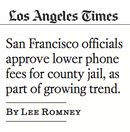 San Francisco Officials looking to reduce price of jail inmates’ phone calls, by Lee Romney, Los Angeles Times, July 6, 2014
San Francisco Officials looking to reduce price of jail inmates’ phone calls, by Lee Romney, Los Angeles Times, July 6, 2014 - The Father’s Day Profiteers That Put Hallmark to Shame, by Leah Sakala, Huffington Post, June 13, 2014
- FCC Bests Prison Telephone Industry Just in Time for Valentine’s Day, by Leah Sakala and Peter Wagner, Huffington Post, February 12, 2014
- FCC caps rates for prison phone calls, by John Ketchum, Marketplace Wealth and Poverty, Thursday, February 12, 2014
 Phoning From Prison, at Prices Through the Roof, by David Segel, New York Times, February 2, 2014
Phoning From Prison, at Prices Through the Roof, by David Segel, New York Times, February 2, 2014 Unfair Phone Charges for Inmates, New York Times editorial, January 6, 2014
Unfair Phone Charges for Inmates, New York Times editorial, January 6, 2014- Prison Phone Call Industry Will Fight New FCC Rules Lowering Rates For Inmates, by Matt Sledge, Huffington Post, September 9, 2013
 FCC caps cost of phone calls to prison inmates, by Andrew McGill, Pittsburgh Post-Gazette, August 10, 2013
FCC caps cost of phone calls to prison inmates, by Andrew McGill, Pittsburgh Post-Gazette, August 10, 2013- The Tyranny Of Prison Phone Charges: ‘Inmates Charged Five Times Usual Rate’, by Matt Stroud, Forbes, July 21, 2013
- Phone Companies In State Prisons Charge Inmates Exorbitant Prices, Give Jails Kickbacks, Group Finds, by Alexander C. Kaufman, International Business Times, June 18, 2013
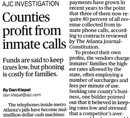 Counties profit from inmate calls, by Dan Klepal, Atlanta Journal-Constitution, June 16, 2013
Counties profit from inmate calls, by Dan Klepal, Atlanta Journal-Constitution, June 16, 2013- Why does it cost so much for prisoners to keep in touch with their families?, The Economist, May 25, 2013
- FCC proposes changes to lower pay-phone rates for prisoners, by Christina Mai-Duc, Los Angeles Times, December 28, 2012
 Hi-Priced Cell Calls, Brian Lehrer Show, December 12, 2012
Hi-Priced Cell Calls, Brian Lehrer Show, December 12, 2012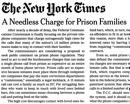 A Needless Charge for Prison Families, by the New York Times editorial board, November 28, 2012
A Needless Charge for Prison Families, by the New York Times editorial board, November 28, 2012 -
 Kickbacks exploit inmates' families, by Rev. Jesse Jackson Sr., Chicago Sun-Times, November 27, 2012
Kickbacks exploit inmates' families, by Rev. Jesse Jackson Sr., Chicago Sun-Times, November 27, 2012  Prison-Phone Rate Cuts Considered by U.S. Regulators, by Todd Shields, Bloomberg Businessweek, November 15, 2012
Prison-Phone Rate Cuts Considered by U.S. Regulators, by Todd Shields, Bloomberg Businessweek, November 15, 2012- State PSC considers lowering 'sinful' prison phone rates, by Katy Reckdahl, The Lens, November 15, 2012
- The Price to Call Home: State-Sanctioned Monopolization in the Prison Phone Industry, by Drew Kukorowski, reprinted and adapted for Prison Legal News, October 2012 issue
- FCC Looks Likely to Cap Phone Rates for Prisoners, by Kaukab Jhumra Smith, Juvenile Justice Information Exchange, October 12, 2012
 Prison Phones Prove Captive Market for Private Equity, by Todd Shields, Bloomberg Businessweek, October 4, 2012
Prison Phones Prove Captive Market for Private Equity, by Todd Shields, Bloomberg Businessweek, October 4, 2012- A Dollar a Minute to Talk to Dad, letter to the editor by Kaytee Riek and Rob Wohl of SumOfUs, Valley Advocate, October 4, 2012
- Kickbacks and Exorbitant Charges Rife In The Monopolized Prison Phone Industry, Pete Brook, Prison Photography Blog, October 2, 2012
 The First Call Is Free; the Rest Are a Fortune, Nancy Scola, American Prospect, October 1, 2012
The First Call Is Free; the Rest Are a Fortune, Nancy Scola, American Prospect, October 1, 2012- Campaign Pressures FCC to Roll Back Exorbitant Expense of Prison Phone Calls, Melinda Tuhus, Between the Lines, September 26, 2012
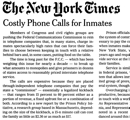 Costly Phone Calls for Inmates, by the New York Times editorial board, September 24, 2012
Costly Phone Calls for Inmates, by the New York Times editorial board, September 24, 2012 - Flying Kites to the FCC Demanding Fair Phone Call Rates for Prisoners and Their Families, Mike Ludwig, Truthout, September 21, 2012
Other news coverage we think you should read
- Criminal Charges: Prison phones are a predatory monopoly. One family fought back — and won., by Colin Lecher, The Verge, May 12, 2016
- How Prison Phone Calls Became A Tax On The Poor, by Eric Markowitz, International Business Times, March 30, 2016
- Not So Securus: Part 2, by Jordan Smith and Micah Lee, The Intercept, February 12, 2016
- Someone Wrote a Sketchy Guide for Evading New Rules on Prison Phone Costs, by Dana Liebelson and Ben Walsh, The Huffington Post, February 10, 2016
- Not So Securus: Massive Hack of 70 Million Prisoner Phone Calls Indicates Violations of Attorney-Client Privilege, by Jordan Smith and Micah Lee, The Intercept, November 11, 2015
- Prison phone rates generate billions for companies, cause stress for black families, by Curtis Bunn, Indianapolis Recorder, October 21, 2015
- The Unnecessarily High Cost of Inmate Calling Charges Is an Injustice, by Senator Cory Booker and Federal Communications Commissioner Mignon Clyburn, Huffington Post, October 13, 2015
- Making Prison Phone Calls Cheaper: Why It Matters, by Rebecca J. Rosen
- Congressional Black Caucus pushes for regulation of prison phone services, by Suzanne Gamboa, Star Tribune, April 24, 2013
- Gouging for prison phone calls means we all pay, Columbus Dispatch, December 12, 2012
Events
- April 15-17, 2025:
Sarah Staudt, our Director of Policy and Advocacy, will be attending the MacArthur Safety and Justice Challenge Network Meeting from April 15-17 in Chicago. Drop her a line if you’d like to meet up!
Not near you?
Invite us to your city, college or organization.






 F.C.C. Makes Telephone Calls for Inmates Cheaper
F.C.C. Makes Telephone Calls for Inmates Cheaper Private companies profit from pay-to-play phone calls in US prisons
Private companies profit from pay-to-play phone calls in US prisons Steep Costs of Inmate Phone Calls Are Under Scrutiny
Steep Costs of Inmate Phone Calls Are Under Scrutiny San Francisco Officials looking to reduce price of jail inmates’ phone calls
San Francisco Officials looking to reduce price of jail inmates’ phone calls Phoning From Prison, at Prices Through the Roof
Phoning From Prison, at Prices Through the Roof Unfair Phone Charges for Inmates
Unfair Phone Charges for Inmates FCC caps cost of phone calls to prison inmates
FCC caps cost of phone calls to prison inmates Counties profit from inmate calls
Counties profit from inmate calls Hi-Priced Cell Calls
Hi-Priced Cell Calls A Needless Charge for Prison Families
A Needless Charge for Prison Families Kickbacks exploit inmates' families
Kickbacks exploit inmates' families The First Call Is Free; the Rest Are a Fortune
The First Call Is Free; the Rest Are a Fortune Costly Phone Calls for Inmates
Costly Phone Calls for Inmates


